Dancing the Nuances of Immigration
An Interview with Lenora Lee and the performers of Lenora Lee Dance
BY EMMALY WIEDERHOLT
Lenora Lee is the artistic director of Lenora Lee Dance, a San Francisco-based company that creates multimedia immersive works about contemporary issues, such as immigration, the military, and illness, to name a few. Her upcoming season features two new works, In Visibility and Convergent Waves: El Paso, that both seek to impart the lived experiences of migrants, descendants, and justice workers as they fight to change the policies that both historically and currently criminalize immigrants, separate families, and contribute to generational trauma. Here, Lenora and some of her dancers talk about their personal relationships to the work and how they hope to broaden perspectives on the issue.
Performances are Friday, February 2 and Saturday, February 3 at 8 p.m. and Sunday, February 4 at 2 p.m. at Dance Mission Theater in San Francisco. Learn more here.
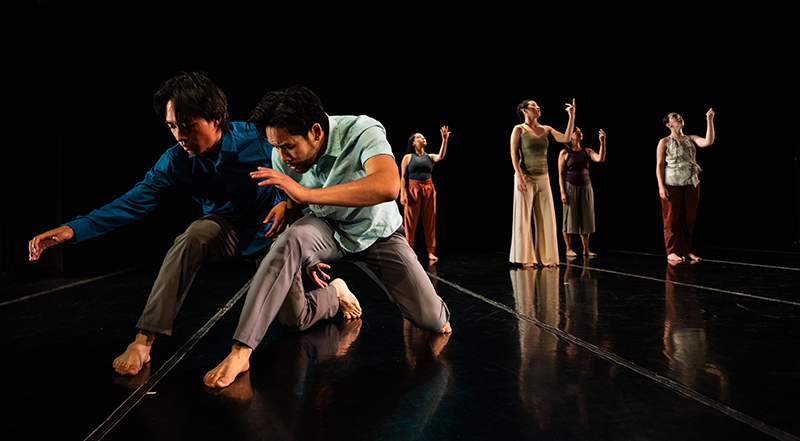
Lenora Lee Dance performing Convergent Waves, Photo by Robbie Sweeny
~~
Lenora, what was some of the driving motivation for your upcoming season that focuses primarily on issues of immigration?
Lenora: I’ve been working on issues of immigration since college in response to my family’s migration to the US from southern China. I was looking at the historical contexts and US policy at the time. In 1882, the US implemented the Chinese Exclusion Act due to the influx of Chinese male laborers. It was only supposed to be in effect for 10 years, but they kept extending it until 1943 when the US became allies with China. They left quotas in place until 1965. There were generations of Chinese who were excluded from this country. That was part of my research starting in college. I like to look at historical and current immigration policy. That’s been my impetus for the past few years. Last year my company focused more on the prison-to-ICE [Immigration and Customs Enforcement] detention pipeline that affects immigrant populations, like the Southeast Asian and Latinx communities. This year’s season is an extension of that.
To the dancers, how did you get involved with Lenora Lee Dance?
Catalina O’Connor: I got involved with Lenora Lee Dance through another of her dancers, SanSan Kwan; we were dancing together with Chingchi Yu and she connected me with Lenora! Prior to that, I’d seen Lenora’s work throughout the Bay.
Victoria Amador: As a UC Berkeley undergrad who has been very passionate about dance, I was thrilled to audition for the 2023 Berkeley Dance Project which connected me to Lenora Lee! This was a dance project that Lenora and members of her company directed with the collaboration of other UC students. Within These Walls was a very emotional but fun piece to be a part of. After the show was over, I was very fortunate to be called back to collaborate and become a cast member for In Visibility and Convergent Waves: El Paso. And I am so happy to continue my dance journey and stay involved with Lenora Lee Dance.
Johnny Huy Nguyễn: My first project with Lenora Lee Dance was in 2017 for Within These Walls, which was an immersive piece taking place within the Angel Island Immigration Station and shone light upon the experiences of Chinese immigrants detained there during the era of Chinese exclusion. The work really helped me to understand that my own individual adverse experiences as an Asian American were connected to a larger history of anti-Asian racism and exclusion. I’ve been dancing with the company since then and have danced in eight major productions.
Lynn Huang: I first met Lenora in 2013 at a contemporary Chinese dance workshop in Berkeley. I had heard of Lenora because she was in a mixed bill performance with my friend in New York and was really happy to meet her. She was doing a show at the de Young Museum and was looking for dancers and I’ve been dancing with Lenora ever since.
Gilberto Martinez Martinez: I got involved with Lenora Lee Dance through Lenora’s restaging of Within These Walls at UC Berkeley. I got to see her choreographic process and ability to involve history and social change through dance and the performance arts.
Lenora, what is your choreographic process?
Lenora: In general, my creative process is collaborative. My dancers and I all generate movement. At the beginning of the process, I share as much as I can about the research and themes involved in the piece. Then we do writing exercises based on similar connections we’ve had or witnessed based on the themes we’re working with. Some of the choreography is generated from writings or experiences. With an immersive piece, we’re inspired by the architecture and layout of the space: How do we transform common public spaces to build a set or environment for different narrative textures and timeframes? I give the dancers feedback on what they are exploring, as well as prompts or inspiration for interacting and connecting while the text and audio score are unfolding.
For the past several years, I’ve been interviewing people from different communities, whether that’s geographic communities or folks that are working with different populations. For the past several projects, I’ve interviewed advocates who are working in support of immigrants and migrants by providing resources, legal counsel, etc. I’ve also done projects on the theme of violence of war, the military, human trafficking, and life-threatening illness. I interview 12 to 30 people in specific communities per project and select excerpts of what they share to create a narrative journey through the audio score. It’s a lot of work but very informative. It brings to the forefront people who are from affected populations, or working on the ground or on the inside, and have lived experiences, knowledge, and/or expertise in ways the public wouldn’t have access to.
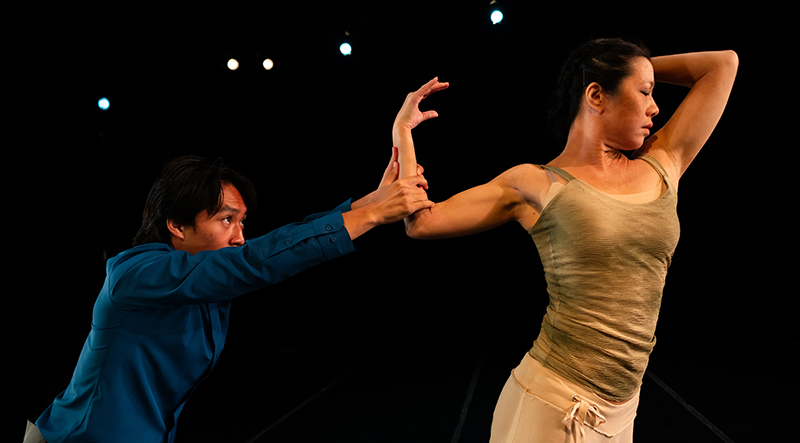
Dancers Sebastian Le and SanSan Kwan, Photo by Robbie Sweeny
Dancers, what has been your experience of the choreographic process so far?
Johnny: The movement I create draws upon the histories that live in my body and an embodied conversation with the various interviewees. It has been eye-opening to learn more about each person’s struggles, triumphs, and histories and to learn more about the exclusionary policies that are affecting so many people’s lives. The biggest thing in working on this project is how we strive to bring the humanity of each person to the forefront as dancers and channel their stories because they need to be heard.
Victoria: Lenora has a unique way of choreographing which allows us the freedom to create and connect. I have gained great skill in my choreography because of this while also being proud of what I am able to contribute to the piece.
Gilberto: I absolutely love the choreographic process. We started with written prompt topics as a source for movement. The experiences we cultivated were written down and sourced from like an almanac without pictures. We got to experience what it would be like to follow how our voice is transcribed as movement while also getting to experience our own ways of moving within the context of each other’s stories. This has been a new take on how I personally create. It has led me to work on my own version of storytelling where it’s also an expression of the internal.
Lynn: I think the choreographic process has been consistent with Lenora’s process in general. I appreciate Lenora’s openness, inclusivity, and generosity in the creative process because she highlights each individual’s unique style and movement qualities.
Catalina: The choreographic process has been very collaborative. We started by creating duets and trios. After crafting these sections, Lenora matched them up with the audio. As a cast, we have discussed which ideas we want to highlight most and how we can use choreographic tools to achieve that. We also spent time with each other listening to the audio and adapting our performance of the movement to highlight the information and stories in a responsible way. Although we all have ties to the material, these experiences are not ours and we have worked as a cast and director to be ethical conduits of the information.
Lenora, can you share more about In Visibility and the inspiration for that piece?
Lenora: For In Visibility, I had the opportunity to interview two individuals recently released from ICE detention (Serafin Andrade, Salesh Prasad) as well as community organizer Sarah Lee and immigration attorney Maddie Boyd. I’ve been doing a lot of site-specific work integrating multimedia and large-scale projections since 2009, and I’ve been doing immersive work since 2015. I love immersive work because it dissolves barriers between audience and performers and creates empathy when we’re in the space together. When audience members are allowed to follow performers and watch the journey unfold in different ways, each audience member can have a different experience depending on which dancer and narrative they are following. The renovated spaces in Dance Mission Theater inspired me to set In Visibility in the multiple spaces. We have a cast of seven and we’re utilizing the entrance stairwell, the lobby, a studio, two small dressing rooms, and a back hallway to create a more intimate environment.
And now can you share more about Convergent Waves: El Paso and the inspiration for that piece?
Lenora: There’s an immigration attorney, Cindy Liou, who I’ve been working with for many years. I interviewed her for my project last year, and she asked me if I wanted to learn more about what’s happening on our southern border and the lifting of Title 42. I was interested because it’s such a contentious issue and has been for the past few years. I took a trip to El Paso and Ciudad Juárez last April. I researched Chinese migration to that region, as well as looked at what’s happening currently that both migrants and advocates are facing. I went through Abara, one of our resource partners, to learn more about how immigration has been affected by policy. Through that work, I want to provide a broader and more detailed perspective about the situation than the way migrants are painted in the mass media.
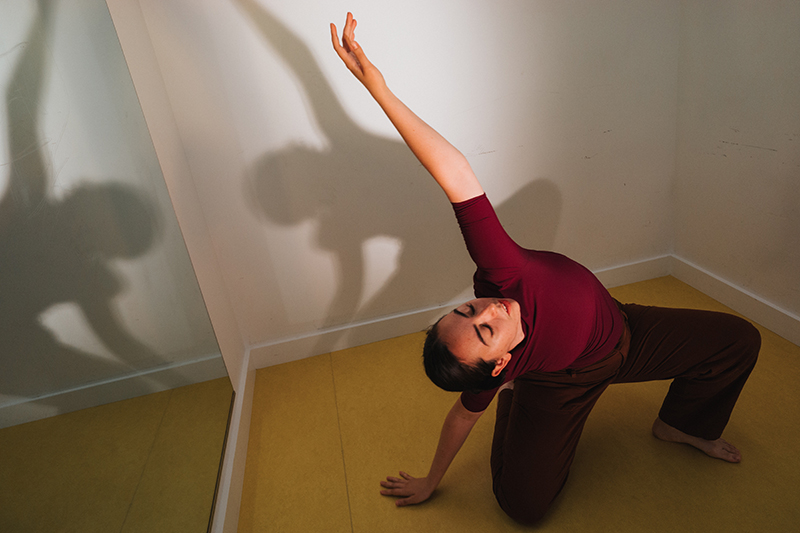
Dancer Catalina O’Connor, photo by Robbie Sweeny
Dancers, what is your connection to either In Visibility or Convergent Waves: El Paso?
Lynn: In Visibility is the sequel to last season’s In the Movement and continues to tell the stories of those who are still struggling against the unjust system of ICE and the criminal justice system. It highlights the systemic oppression of immigrant populations and the hypocrisy of the American dream in relation to current government policies as told through individual stories – of their heartbreak and their triumphs. Last year’s In the Movement was significant also because it premiered right as the VISION Act (which would have protected refugee and immigrant community members who have already been deemed eligible for release from being funneled by local jails and our state prison system to immigration detention) was shut down on the floor of Congress. I still remember that day as we learned that the act failed and how heartbreaking it was to know that these stories we were listening to and dancing to would not be protected by law. As a sequel, In Visibility continues to tell these stories of injustice, as well as how individuals in the system are currently fighting and advocating. This retelling through immersive dance allows viewers into the struggle in order to deepen their awareness.
Convergent Waves: El Paso is also significant to me in the way that it ties in migration stories over history, from the first Chinese settlers into El Paso, and to hear the stories of their descendants, to the current reality in El Paso, as continued migration across the borders in all its painful realities mirrors the past. We are all in this history together and it is a privilege and a necessity to uphold and uplift these stories so they can be remembered and celebrated.
Catalina: Immigration makes up very recent history on both sides of my family. We come from a few different places, but migration has affected each branch of my family tree. So the content of Convergent Waves: El Paso is really personal to me. Hearing people who have crossed borders speak about their own experiences reminds me of my family members; it’s very powerful to hear their voices on stage.
Victoria: I feel very connected to this piece because it deals with the hardships that come with immigrating to a new place. I have very close family that immigrated to the US, and although I will never experience what my family or other migrants experience/ed I am glad I am able to amplify their stories through the art of dance.
Gilberto: My connection to Convergent Waves: El Paso is both through dance and in history. I am fascinated by how Lenora uses different facets to create the work she edits together. I look to her as a choreographic mentor and inspiration for my own work. On the topic of Convergent Waves: El Paso, I have family living in and from Ciudad Juárez, Mexico. The El Paso border crossing is a sore topic. While they’ve tried to cross it, they have been turned back so many times, leading them to settle in Juárez. Unfortunately, once someone sets roots, it is much harder to step away. They have ended up staying and living their lives there. I want to learn more about my heritage and how we got to where we are now. The border stories are the biggest ones to date, both in glory and horrifying truths. As I keep learning what happened in our histories, I strive to uncover the truths behind what really transpired versus the edited versions our parents and American textbooks tell us for the sake of being children.
Johnny: My parents are both Vietnamese refugees so the issues around immigration and who is allowed or not allowed into our country are close to home for me. The incarceration-to-ICE pipeline is also something that disproportionately impacts Southeast Asian communities which have been ravaged by colonization and US imperialism. There are so many dehumanizing misconceptions and false narratives around immigrants and refugees. It is a very difficult and heartbreaking decision to leave your home and everything you know behind. It’s hard starting again in a new country with so many systemic barriers stacked against you. Yet many immigrants and refugees make this decision time and again because the conditions in their countries of origin are so brutal often due to US foreign policy.
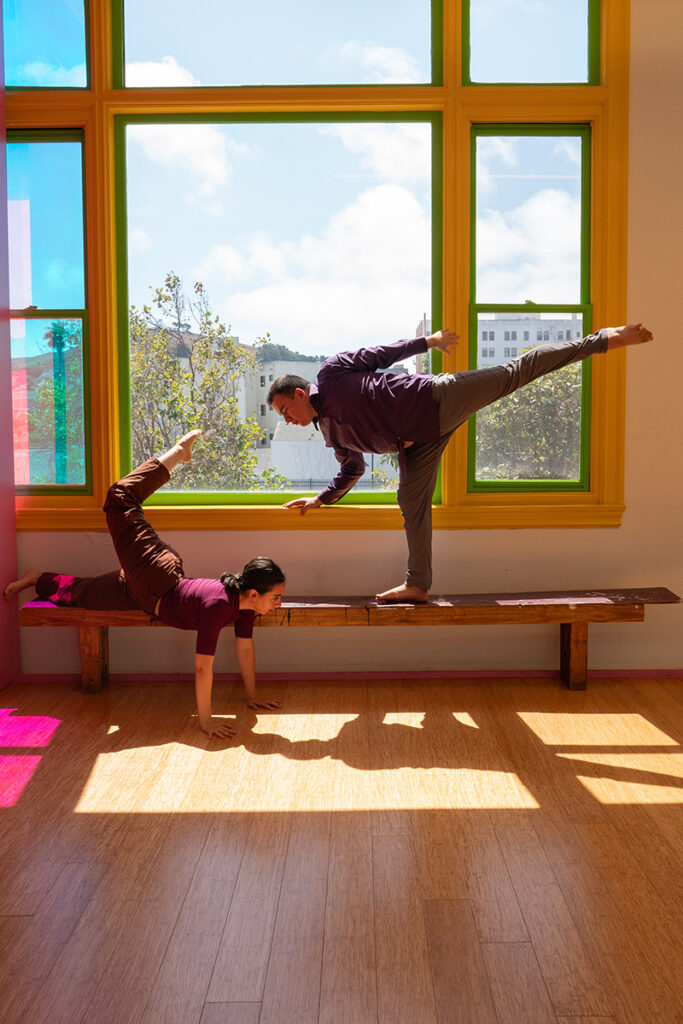
Dancers Catalina O’Connor and Gilberto Martinez Martinez, Photo by Robbie Sweeny
Lenora, why is it important to make dances about social issues like immigration? How can dance impact or add to the conversation about these issues?
Lenora: The first large immersive project I did was in 2015 about the violence of war and violence within the military. As I was walking around and watching audience members experience the work, I felt like people were more deeply affected. As someone who creates performance experiences, that’s one of my goals: How can we deeply connect with others given the time we have and the platform we have? Ever since I changed my major in college from Biochemistry to Dance, I was encouraged to create work that focused on communities and bring in my own experiences of communities I was a part of or had the privilege of witnessing or getting to know. It just made sense from the beginning. I was a quiet person, someone who didn’t like public speaking or voicing my opinion in large groups. For me, movement was a first language, and has so much more nuance than speaking.
In 2010, when I created my first traveling multimedia work about Chinese migration, it ended up not just being about my family’s exclusion, but represented the exclusion of the hundreds of thousands of Chinese affected by anti-immigrant policies such as the 1882 Chinese Exclusion Act. A question I’ve been trying to explore through the years is: How can I provide an empathetic experience for people to see the details of a community or population that is misunderstood in the public eye?
What do you hope audiences take away?
Lenora: I’m hoping that by hearing firsthand from affected individuals, advocates, and attorneys working to support and stabilize migrants and their families that audiences have a clearer understanding of how complex the issues are and how much support immigrants, refugees, and asylum seekers need. I want to get away from talking about migrants as numbers and for audiences to see the lives people live and the multiple reasons they might be choosing to come to the US, as well as how immigration reform is necessary. There are a lot of things that need to shift in order for the systems to operate smoothly. The anti-immigrant sentiment is growing. How can we provide other perspectives to broaden people’s understanding.
Gilberto: If there is only one thing the audience takes away, I hope it is curiosity. I feel like the show is so full of information and experiences in such a good way that taking all the info in seems nearly impossible. I hope the show leaves the audience with genuine curiosity to expand their own knowledge on what I consider to be our truths.
Lynn: I hope audiences are affected by the stories, the text, the movement, the visuals, the journey of being in this work. As an immersive piece, it brings people into another world, and the act of walking through it, making choices, listening, interpreting, maybe struggling to comprehend or follow is an act of resistance. Through these smaller acts of resistance, I hope we might see them come together additively into larger waves of resistance and change.
Johnny: I hope audiences come away with a deeper understanding of the histories and contemporary issues that are embedded within the current immigration crisis and policies. By bearing witness to the stories in motion, I hope the audience can deepen into compassion and empathy on an embodied level, be moved to take even the smallest actions as advocates, and see the world and the people around them with greater understanding for the struggles of immigrants and refugees.
Catalina: There’s a lot of very rich information in this show: experiences highlighting the connection between immigration and incarceration, lived histories from people who have crossed the border and their descendants, and policy analysis from advocates and attorneys working with communities in El Paso. I hope the audience can take this in to gain a more nuanced understanding of the US immigration system. Apart from this and despite the fact that this work focuses primarily on El Paso, I hope that the audience takes time to reflect on how the content of this show is not isolated to Texas and the Trump administration. These issues exist in the Bay Area too, and the Biden administration has expanded harmful immigration policies. There is still so much harm within the US legal and immigration systems, and I hope audiences are inspired to listen to and learn from immigrants and organizations on how we can actively make changes in our communities.
Victoria: I hope they are able to have empathy towards the stories being told, understand each person’s story individually, while being moved and impacted by the piece as a whole. There is so much to learn through this piece. There’s so much to enjoy as well! As long as they are able to feel an impact, that alone is something they can take away.
Any other thoughts?
Lenora: This show feels like a milestone; it’s 15 years of running the company and 25 years of my working in the field. I hope we’re able to communicate in a compassionate way the issues at hand and give justice to the people impacted by the policies and those working in the field and going through these experiences on a daily basis.
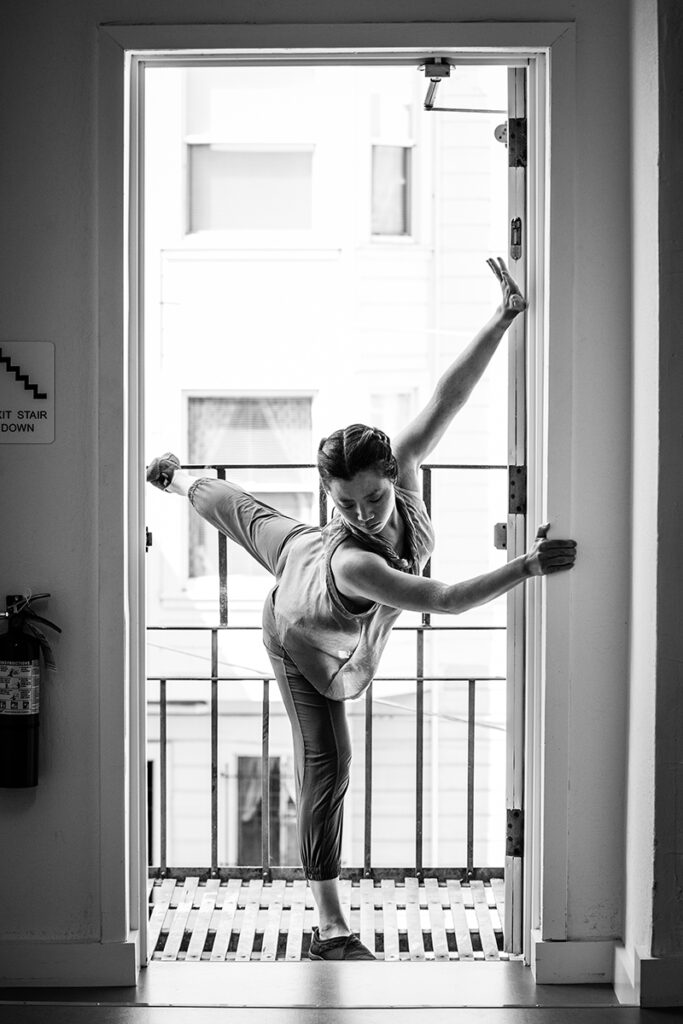
Dancer Lynn Huang, Photo by Robbie Sweeny
~~
To learn more, visit www.lenoraleedance.com.

One Response to “Dancing the Nuances of Immigration”
Another terrific article Emmaly!
I’m a fan of Lynn Hyung!
Comments are closed.